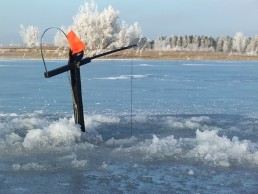Wind Tip-ups Enhance Bait Action and Attraction
SHARE THIS POST
Even a seasoned ice fisherman like Geremy Olson can find new techniques and different gear to keep winter fishing interesting.
Many years ago, I was on one of my favorite spots when a guy pulled up on the opposite side of the sunken island I was ice-fishing, and started to set up. He pulled out the weirdest contraption I had ever seen, and started to fish. I wandered over to investigate.
This was the day that I was introduced to the Windlass tip-up. What left a lasting impression on me is that guy and his tip-up out-fished me 10:1 that night. So, like any good angler, I went and bought one the next day. Many years later, I am still learning new and unique ways to use wind tip-ups.
The concept is pretty simple. Wind catches the silver paddle that jigs or moves your baits. You can adjust almost everything on the tip-up, from spring tension to spool drag to angle of the unit. When you’re done, it collapses down nice and neat to fit in your sled or bucket.
Setup on these tip-ups is also simple. However, there are a few things I have learned the hard way.
When I bought my first wind tip-up, I put the smallest diameter braid I could find on it. It fished really well, but after the first couple of fish caught with a hand-over-hand retrieve, it was easier to cut the line than try to get all the knots out.
Nowadays, on my walleye setups, I like to use either 10-pound mono, or 20- to 30-pound Fire Line Crystal attached via a ball bearing swivel to a 24- to 36-inch fluorocarbon leader. When it comes to pike, I have found a waxed 30-pound braided nylon works best, using a Coastlock snap swivel to connect the rig of the day.
When spooling the line, a couple of wraps of electrical tape works well to keep the line from slipping on the spool.
Slush from drilling your holes works best for holding your tip-up in place. Wet snow tends to freeze well enough to require a fun-filled chipping party.
Finally, on pike setups, I have found that bending the corners of the paddle helps catch more wind when using bigger baits.
Are you enjoying this post?
You can be among the first to get the latest info on where to go, what to use and how to use it!
These tip-ups can be used with countless options. There isn’t much you can put under a wind tip-up that won’t work. My starting points for walleyes and big perch are small Perch Eye or Wide Gap jigs that glow in the dark, when I am fishing the evening bite. During the day, I start with shiny jigging spoons like Swedish Pimples and Kastmasters. When fishing murky water on windy days, anything with a rattle works well.
Never underestimate the power of a plain hook or a hook and bead combination. The last couple of years, we started using swimming baits under wind tip-ups during early and late ice.
When it comes to pike, I love using quick-strike rigs with smaller smelt. This way I get more action out of the tip-up and rig. Typically with this set up I like to place with the bait just under the ice or halfway down in the water column. This allows the pike to see them the best and the extra movement will bring a pike off the bottom even in 40 feet of water to hit that bait.
I like using wind tip-ups in two main ways. The first setup is placing a wind tip-up in the middle of a set of dead stick rigs or traditional tip-ups. The jigging action creates an enticing menu option for the fish.
This action is as sporadic as the wind, and is extremely different from any action you can try to replicate with a jigging rod. There are days when we never catch a fish on the wind tip-up, but catch fish only on traditional tip-ups set around a wind tip-up. This tactic works for both walleyes and pike.
The second way I like to fish them is on a line covering an entrance to a feeding spot. I call it “deer hunting for fish.” There are spots that, after a couple years of fishing, you just know that fish are going to come to that spot at around a specific time.
There is a drop-off where we catch walleyes every year during first ice, for about an hour and a half. We set up a line of wind tip-ups furthest from the final destination, followed by a set of traditional tip-ups. Then we jig on the bull’s-eye where we expect the fish to be coming. This way, you are set up for both the active and inactive fish.
So, as you are getting stocked up for this ice-fishing season, take a look at wind tip-ups and give them a try. They are versatile, and worth having in the sled.
Are you looking to change up your ice-fishing routine? You’ll find lots of helpful information in the winter issues of MidWest Outdoors, available at the newsstand or by subscribing on our website.
MWO
SHARE THIS POST
You may also like...
Nothing found.
Did you enjoy this post?
You can be among the first to get the latest info on where to go, what to use and how to use it!
Geremy Olson
Geremy Olson grew up in the outdoors. After being burned as a volunteer firefighter, he had to figure out how to teach outdoor skills to his children from a wheelchair while learning to walk. Today he is an inspirational speaker, FCA Outdoors volunteer, tournament director, video producer, wildfire consultant and proud father of the owners of Missouri Secrets Tackle. GOspeaks.live.
